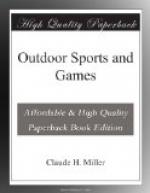After we have prepared the hypo and the developer we are ready to develop the plate. Place it face side up in the tray and quickly pour the developer over it, being sure that the solution covers the surface immediately, to avoid unequal development. While we should not develop in a strong red or yellow light we can at least place our tray in such a position that we may watch the process of bringing up the image out of the creamy surface of the plate. This is the most fascinating part of photography. First the high lights will appear and then the shadows, and then after an instant the whole image will come into view and then begin to fade away. To know at what point development should stop will only come by experience with negatives of all sorts of classes. Generally speaking, when the image fades from view and begins to appear through the film on the glass side we should wash it quickly and immerse it in the hypo. The “fixing” in hypo will take probably five minutes and should be continued until the white coating is thoroughly dissolved. The plate may then be brought safely to the light and should be washed thoroughly either in running water for half an hour or in at least twelve changes of fresh water. Care must be taken not to touch the film side of the plate during development or fixing, as the gelatine coating becomes very soft and will show the slightest scratch or abrasion. We must dry the plate away from dust, sunlight, or artificial heat. After it is dry we are ready to make a print.
Photographic printing papers are of two classes—those which are used in direct sunlight and upon which the image gradually appears, and those which are similar to plates and which are given a very short time exposure in artificial light and the picture developed just as we should a plate. The beginner will probably have more uniform success with sunlight paper after the simple process of toning and fixing is learned, although the developing papers are extremely simple to handle and give better results.
The final step of trimming and mounting the print is too simple to require explanation.
There are a great many things that might be said about photography, but in a book of this kind only the most simple facts are stated. If you become a photographer you will soon learn many of the fine points.
Our negatives should all be kept carefully in labelled envelopes and a record kept in a book of some kind.
When we really become expert as a photographer, there are many opportunities to make our hobby pay. The publishers of nearly all the magazines experience the greatest difficulty in securing the kind of pictures they wish to reproduce. This is remarkable when so many people are taking pictures. If one wishes to sell pictures, it is important to study the class of materials that the magazines use. Then, if we can secure good results, we can be almost sure of disposing of some of our work and, in addition to the money, have the satisfaction of seeing our pictures published.




